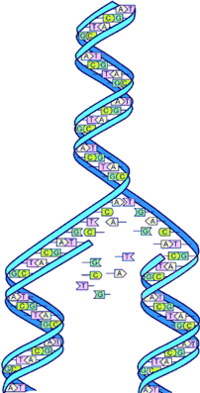Double helix: Difference between revisions
Appearance
Content deleted Content added
No edit summary |
No edit summary |
||
| Line 4: | Line 4: | ||
In [[geometry]] a '''double helix''' (plural ''helices'') typically consists of two [[congruence (geometry)|congruent]] [[helix|helices]] with the same axis, differing by a [[translation (physics)|translation]] along the axis, which may or may not be half-way.<ref>[http://demonstrations.wolfram.com/DoubleHelix/ "Double Helix"] by Sándor Kabai, [[The Wolfram Demonstrations Project]], 2007.</ref> |
In [[geometry]] a '''double helix''' (plural ''helices'') typically consists of two [[congruence (geometry)|congruent]] [[helix|helices]] with the same axis, differing by a [[translation (physics)|translation]] along the axis, which may or may not be half-way.<ref>[http://demonstrations.wolfram.com/DoubleHelix/ "Double Helix"] by Sándor Kabai, [[The Wolfram Demonstrations Project]], 2007.</ref> |
||
It was first published that the double helix is the structure of [[DNA]] by [[James D. Watson]] and [[Francis Crick]] in 1953, |
It was first published that the double helix is the structure of [[DNA]] by [[James D. Watson]] and [[Francis Crick]] in 1953, stolen from work by [[Rosalind Franklin]] by [[Maurice Wilkins]].<ref> [http://dnareplication.info/dnadoublehelix.php Double Helix] by George Kakaris, Biologist MSc in Applied Genetics and Biotechnology </ref> The double helix shape is very strong. DNA takes this shape over a straight shape naturally for two reasons. It must be 'double' so it can reproduce itself and the helix, being intertwined, is stronger than two parallel chains because pulling it in any one direction won't break it apart. |
||
==References== |
==References== |
||
Revision as of 17:24, 30 April 2008
- For other meanings of double helix, see Double helix (disambiguation)


In geometry a double helix (plural helices) typically consists of two congruent helices with the same axis, differing by a translation along the axis, which may or may not be half-way.[1]
It was first published that the double helix is the structure of DNA by James D. Watson and Francis Crick in 1953, stolen from work by Rosalind Franklin by Maurice Wilkins.[2] The double helix shape is very strong. DNA takes this shape over a straight shape naturally for two reasons. It must be 'double' so it can reproduce itself and the helix, being intertwined, is stronger than two parallel chains because pulling it in any one direction won't break it apart.
References
- ^ "Double Helix" by Sándor Kabai, The Wolfram Demonstrations Project, 2007.
- ^ Double Helix by George Kakaris, Biologist MSc in Applied Genetics and Biotechnology
See also
